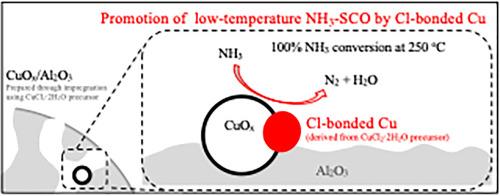CuOx/Al2O3表面的低温NH3-SCO被前驱体衍生的cl键合Cu增强
IF 7.1
Q1 ENGINEERING, CHEMICAL
引用次数: 0
摘要
考察了铜前驱体的选择对浸渍法制备CuOx/Al2O3催化剂催化性能的影响。采用不同的铜前驱体:乙酰丙酮铜、硝酸铜、硫酸铜和氯化铜,合成了四种催化剂。我们评估了它们在NH3氧化中的催化活性,以及它们的结构和表面性质,以阐明前体选择、表面物种形成和催化性能之间的关系。x射线光电子能谱(XPS)和飞行时间二次离子质谱(ToF-SIMS)揭示了前驱体中不同阴离子组分形成的不同表面物质。其中,由氯化铜生成的CuCl2等表面cl键合Cu物种显著提高了催化活性,而与硫酸铜前体形成的CuSO4物种显著降低了催化活性。用最优量的氯化铜前驱体制备的催化剂在较宽的温度范围(230-360℃)内实现了100%的NH3转化率。此外,在250°C条件下,在510 min的时间内,它可以完全去除NH3, N2选择性超过70%。在600℃长时间退火后,形成了新的Cu键合态Cu2(OH)3Cl,促进了NH3在低温(< 160℃)下的氧化。这些发现强调了前驱体衍生的表面物质,特别是cl键Cu物质在提高CuOx/Al2O3催化剂NH3-SCO活性中的促进作用。本文章由计算机程序翻译,如有差异,请以英文原文为准。

Low-temperature NH3-SCO over CuOx/Al2O3 enhanced by precursor-derived Cl-bonded Cu species
We examined how the choice of copper precursor influences the catalytic performance of CuOx/Al2O3 catalysts prepared via impregnation. Four types of catalysts were synthesized using different copper precursors: copper acetylacetonate, copper nitrate, copper sulfate, and copper chloride. Their catalytic activity in NH3 oxidation was evaluated alongside their structures and surface properties to elucidate the relationships between precursor selection, surface species formation, and catalytic performance. X-ray photoelectron spectroscopy (XPS) and time-of-flight secondary ion mass spectroscopy (ToF-SIMS) revealed the formation of distinct surface species originating from different anionic components of precursors. Particularly, surface Cl-bonded Cu species such as CuCl2 from copper chloride markedly enhanced the catalytic activity, while the CuSO4 species formedi with copper sulfate precursor significantly reduced the activity. The catalyst prepared with an optimal amount of copper chloride precursor achieved 100 % NH3 conversion over a broad temperature range (230–360 °C). Furthermore, it maintained complete NH3 removal at 250 °C for 510 min, with N2 selectivity exceeding 70 %. New Cl-bonded Cu species such as Cu2(OH)3Cl species was formed upon prolonged annealing at 600 °C, which promoted NH3 oxidation at low temperatures (< 160 °C). These findings highlight the crucial role of precursor-derived surface species, particularly the promotional effect of Cl-bonded Cu species, in enhancing the NH3-SCO activity of CuOx/Al2O3 catalyst.
求助全文
通过发布文献求助,成功后即可免费获取论文全文。
去求助
来源期刊

Chemical Engineering Journal Advances
Engineering-Industrial and Manufacturing Engineering
CiteScore
8.30
自引率
0.00%
发文量
213
审稿时长
26 days
 求助内容:
求助内容: 应助结果提醒方式:
应助结果提醒方式:


